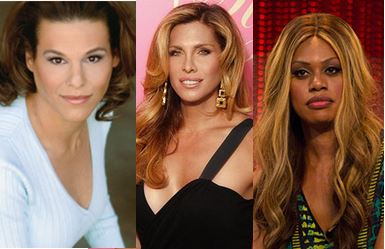
In the current golden era of TV, storytelling is the most progressive that audiences have seen with almost all members of the LGBT community finding representation on screen—most recently, the “T.” However, with all that accolades that have come with Transparent, Laverne Cox and more, it’s easy to forget the decades of negative transgender portrayals that come before. OUT magazine contributor Stacy Lambe recently chatted with Cox, Alexandra Billings, Candice Cayne, and more who explain there’s still a lot of ignorance to overcome.
Read the full OUT article here:
Select quotes from the article follow:
Laverne Cox: My dear friend Valerie Spencer told me—after she watched my topless scene in Orange Is the New Black—that the narrative is now changed because our bodies are no longer shameful. This is it. This is what our bodies look like—not this mysterious thing. Now we can move on. And I think Sense8 has moved onto something way beyond.
Cox: It’s interesting for me—and I’ve talked to a few people about this—as a black actress, whether a role is written for a black actress or not, once I play her the character becomes black. I wonder if the character becomes trans when I play her. I did a guest spot on MTV’s Faking It, in which I played a high school drama teacher named Margo. The character was not written as trans and there was no mention of her being transgender in the trajectory of the narrative, but I wonder does she become trans when I play her?
Alexandra Billings, Transparent: I was 16 or 17, living in Illinois. I really thought at that point that everyone would be better off without me on the planet. I was creating a lot of problems, and I was sad a lot. I was terribly confused and very angry. I was secretly dressing up. I don’t know why, but I knew it was shameful. I remember it was a late afternoon on a Friday, my parents were at work and the house was empty. I got a big fistful of pills from my mom’s medicine cabinet and I thought, This is what I’m going to do. So I went into my room, and I turned on the television, which I did automatically because I’m a TV baby. On came Phil Donahue and on his show were these four fabulous looking, what I assumed were strippers, and they were eloquent and funny and witty and happy. I thought, Those were some happy strippers. Then I remember the audience asking the strangest questions like, ‘Which bathroom do you use?’ I’m sitting there on the edge of my bed with a handful of pills and as the show went on, I found out those four women were actually four men. That was an epiphany for me. I sat there and I thought, There I am. That was the first time I had actually seen myself. Then I started having vocabulary for who I was. That was the beginning of a brand new freedom. That’s when I transitioned.
Candis Cayne: On an episode of CSI I did early on, I talked to the producers and the writers about how to make the character more realistic. You know, not dying in the men’s room but dying in the women’s room, not standing at the urinal or in the stall. If I’m going to get murdered with my head stuffed in a toilet and drowned—which is disgusting, but it’s television—at least make it an accurate portrayal.
Cayne: I didn’t realize how big Dirty Sexy Money was until I went to set and then realized it was Billy Baldwin I was doing it with. We had an immediate connection. It was kind of cool. I was only supposed to do one or two episodes and then it ended up lasting the life of the show. It was written really well and my character was in love with this man and he was in love with her too. I realized that had never been portrayed, but I had no idea how big the impact would be socially until I was three to four episodes in and people started to realize that this was making the world aware of the fact that there are normal feeling trans women out there.











